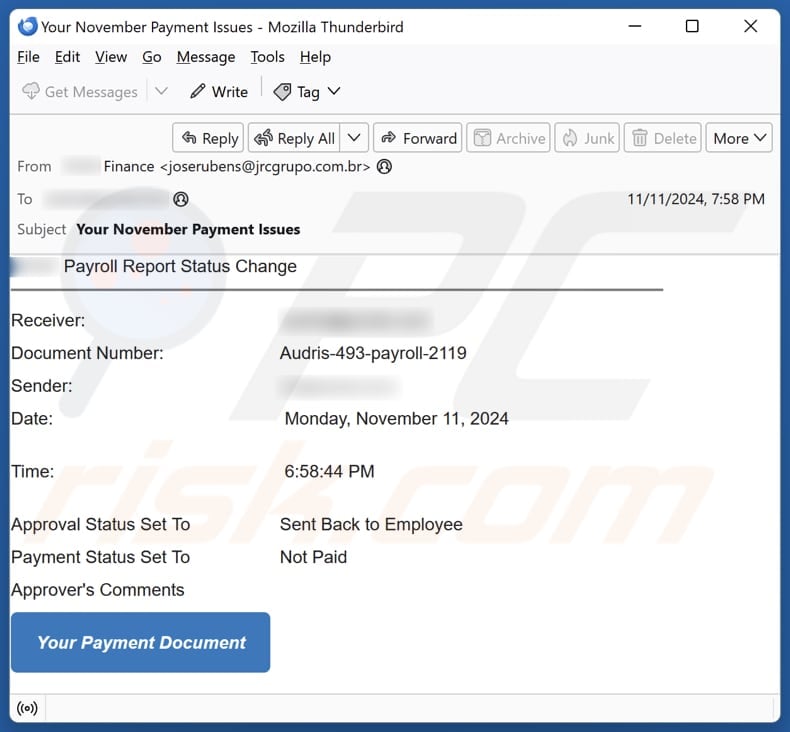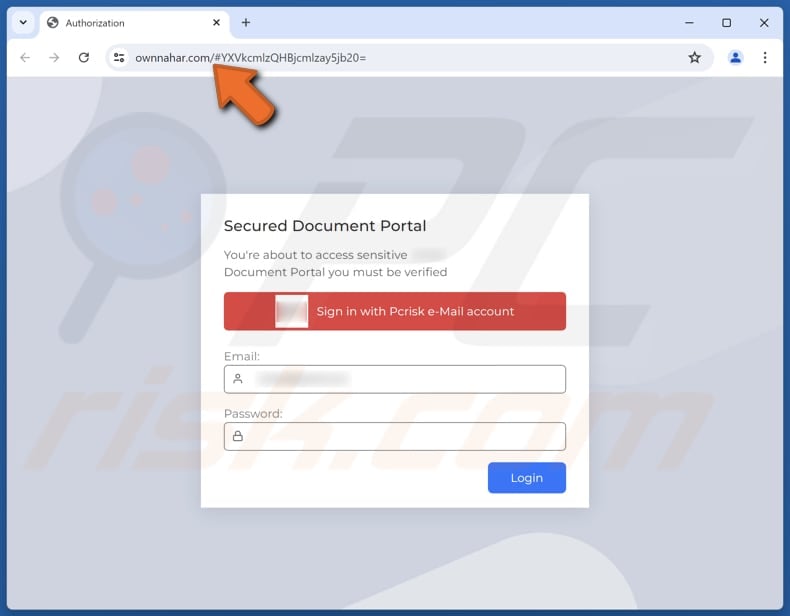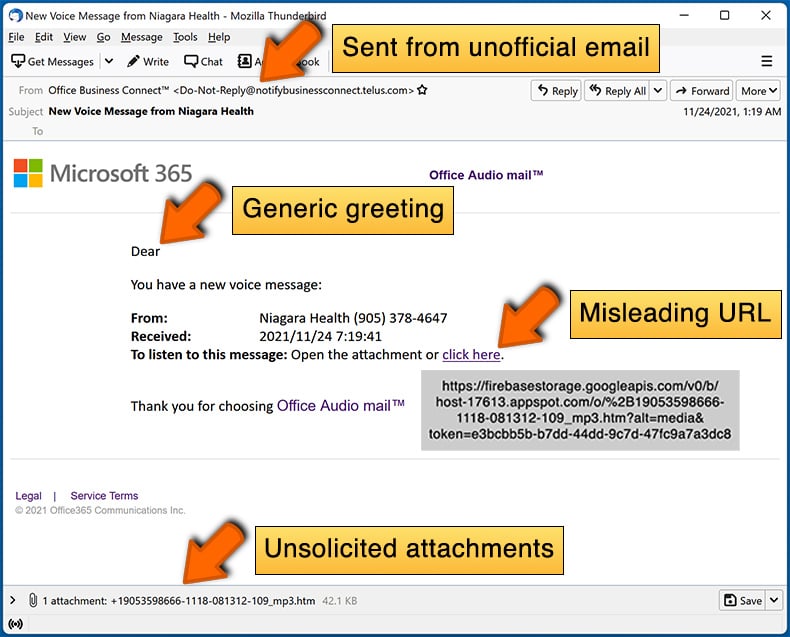How to recognize scam emails like "Payroll Report Status"
Phishing/ScamAlso Known As: Payroll Report Status phishing email
Get free scan and check if your device is infected.
Remove it nowTo use full-featured product, you have to purchase a license for Combo Cleaner. Seven days free trial available. Combo Cleaner is owned and operated by RCS LT, the parent company of PCRisk.com.
What is "Payroll Report Status"?
We have inspected this email and learned that its purpose is to extract personal information from recipients. Emails of this type are classified as phishing emails. This particular email is disguised as a letter regarding a change in the payroll report status to appear legitimate and lure recipients into opening a deceptive website.

More about the "Payroll Report Status" scam email
This phishing email notifies the recipient about a payroll status change. It states that the payment status has been marked as "Not Paid", and the approval status has been sent back to the employee. The email also includes a fake document to trick the recipient into thinking it is a legitimate notification.
The goal is to trick the recipient into opening a deceptive page through the "Your Payment Document" link (button) and disclosing personal information. The deceptive site used in this scam poses as a "Secured Document Portal" and instructs visitors to sign in using their email account login credentials to access a sensitive document.
The entered information (login credentials) is sent to scammers who can use it for various malicious purposes. For instance, they can access email accounts and send phishing emails to contacts. Also, they can look for personal information within emails, try to access other (e.g., social media) accounts, and sell the harvested details to other cybercriminals.
Overall, falling for this phishing campaign can result in identity theft, monetary loss, and other issues. Therefore, it is important to examine emails before opening links and providing personal information.
| Name | Payroll Report Status |
| Threat Type | Phishing, Scam, Social Engineering, Fraud |
| Fake Claim | A payment has not been paid |
| Related Domain | ownnahar[.]com |
| Detection Names | CyRadar (Phishing), ESET (Phishing), Fortinet (Phishing), Trustwave (Phishing), Full List Of Detections (VirusTotal) |
| Disguise | Letter regarding a change in the payroll report status |
| Symptoms | Unauthorized online purchases, changed online account passwords, identity theft, illegal access of the computer. |
| Distribution methods | Deceptive emails, rogue online pop-up ads, search engine poisoning techniques, misspelled domains. |
| Damage | Loss of sensitive private information, monetary loss, identity theft. |
| Malware Removal (Windows) |
To eliminate possible malware infections, scan your computer with legitimate antivirus software. Our security researchers recommend using Combo Cleaner. Download Combo CleanerTo use full-featured product, you have to purchase a license for Combo Cleaner. 7 days free trial available. Combo Cleaner is owned and operated by RCS LT, the parent company of PCRisk.com. |
Similar scam emails in general
These emails are utilized to lure recipients into providing sensitive information like passwords, financial details, ID card details, etc. They often look like legitimate letters from trusted organizations, companies, or other entities and contain links to deceptive pages.
Examples of such emails are "Email Password Time Running Out", "New Security Updates On Email Servers", and "Server Has Been Updated - Refresh Your Email". It is important to note that threat actors often use email to trick users into infecting their systems.
How do spam campaigns infect computers?
Cybercriminals deceive users into running malware on their computers by sending malicious files or links through email. Malware can enter systems when users interact with harmful files, such as by opening executables, enabling macros in compromised MS Office documents, or performing other actions.
Links in these fake emails may lead users to deceptive websites, where they can be lured into downloading malware or exposed to automatic downloads that can infect their devices.
How to avoid installation of malware?
Download apps and files only from reliable sources, such as official app stores, and steer clear of pirated software, key generators, or cracks. Avoid using peer-to-peer networks, third-party downloaders, or questionable websites for downloads. Be cautious with unexpected emails from unknown senders, especially if they include links or attachments.
Do not trust/click pop-ups and ads on untrustworthy sites, and ensure that your security software, apps, and operating system are kept up to date. If you have already opened malicious attachments, we recommend running a scan with Combo Cleaner Antivirus for Windows to automatically eliminate infiltrated malware.
Text presented in the "Payroll Report Status" email letter:
Subject: Your November Payment Issues
******** Payroll Report Status Change
Receiver: ********
Document Number: *****-493-payroll-2119
Sender: ********
Date: Monday, November 11, 2024
Time: 6:58:44 PM
Approval Status Set To Sent Back to Employee
Payment Status Set To Not Paid
Approver's Comments
Your Payment Document
Phishing website used in this scam:

Instant automatic malware removal:
Manual threat removal might be a lengthy and complicated process that requires advanced IT skills. Combo Cleaner is a professional automatic malware removal tool that is recommended to get rid of malware. Download it by clicking the button below:
DOWNLOAD Combo CleanerBy downloading any software listed on this website you agree to our Privacy Policy and Terms of Use. To use full-featured product, you have to purchase a license for Combo Cleaner. 7 days free trial available. Combo Cleaner is owned and operated by RCS LT, the parent company of PCRisk.com.
Quick menu:
- What is Payroll Report Status phishing email?
- Types of malicious emails.
- How to spot a malicious email?
- What to do if you fell for an email scam?
Types of malicious emails:
![]() Phishing Emails
Phishing Emails
Most commonly, cybercriminals use deceptive emails to trick Internet users into giving away their sensitive private information, for example, login information for various online services, email accounts, or online banking information.
Such attacks are called phishing. In a phishing attack, cybercriminals usually send an email message with some popular service logo (for example, Microsoft, DHL, Amazon, Netflix), create urgency (wrong shipping address, expired password, etc.), and place a link which they hope their potential victims will click on.
After clicking the link presented in such email message, victims are redirected to a fake website that looks identical or extremely similar to the original one. Victims are then asked to enter their password, credit card details, or some other information that gets stolen by cybercriminals.
![]() Emails with Malicious Attachments
Emails with Malicious Attachments
Another popular attack vector is email spam with malicious attachments that infect users' computers with malware. Malicious attachments usually carry trojans that are capable of stealing passwords, banking information, and other sensitive information.
In such attacks, cybercriminals' main goal is to trick their potential victims into opening an infected email attachment. To achieve this goal, email messages usually talk about recently received invoices, faxes, or voice messages.
If a potential victim falls for the lure and opens the attachment, their computers get infected, and cybercriminals can collect a lot of sensitive information.
While it's a more complicated method to steal personal information (spam filters and antivirus programs usually detect such attempts), if successful, cybercriminals can get a much wider array of data and can collect information for a long period of time.
![]() Sextortion Emails
Sextortion Emails
This is a type of phishing. In this case, users receive an email claiming that a cybercriminal could access the webcam of the potential victim and has a video recording of one's masturbation.
To get rid of the video, victims are asked to pay a ransom (usually using Bitcoin or another cryptocurrency). Nevertheless, all of these claims are false - users who receive such emails should ignore and delete them.
How to spot a malicious email?
While cyber criminals try to make their lure emails look trustworthy, here are some things that you should look for when trying to spot a phishing email:
- Check the sender's ("from") email address: Hover your mouse over the "from" address and check if it's legitimate. For example, if you received an email from Microsoft, be sure to check if the email address is @microsoft.com and not something suspicious like @m1crosoft.com, @microsfot.com, @account-security-noreply.com, etc.
- Check for generic greetings: If the greeting in the email is "Dear user", "Dear @youremail.com", "Dear valued customer", this should raise suspiciousness. Most commonly, companies call you by your name. Lack of this information could signal a phishing attempt.
- Check the links in the email: Hover your mouse over the link presented in the email, if the link that appears seems suspicious, don't click it. For example, if you received an email from Microsoft and the link in the email shows that it will go to firebasestorage.googleapis.com/v0... you shouldn't trust it. It's best not to click any links in the emails but to visit the company website that sent you the email in the first place.
- Don't blindly trust email attachments: Most commonly, legitimate companies will ask you to log in to their website and to view any documents there; if you received an email with an attachment, it's a good idea to scan it with an antivirus application. Infected email attachments are a common attack vector used by cybercriminals.
To minimise the risk of opening phishing and malicious emails we recommend using Combo Cleaner Antivirus for Windows.
Example of a spam email:

What to do if you fell for an email scam?
- If you clicked on a link in a phishing email and entered your password - be sure to change your password as soon as possible. Usually, cybercriminals collect stolen credentials and then sell them to other groups that use them for malicious purposes. If you change your password in a timely manner, there's a chance that criminals won't have enough time to do any damage.
- If you entered your credit card information - contact your bank as soon as possible and explain the situation. There's a good chance that you will need to cancel your compromised credit card and get a new one.
- If you see any signs of identity theft - you should immediately contact the Federal Trade Commission. This institution will collect information about your situation and create a personal recovery plan.
- If you opened a malicious attachment - your computer is probably infected, you should scan it with a reputable antivirus application. For this purpose, we recommend using Combo Cleaner Antivirus for Windows.
- Help other Internet users - report phishing emails to Anti-Phishing Working Group, FBI’s Internet Crime Complaint Center, National Fraud Information Center and U.S. Department of Justice.
Frequently Asked Questions (FAQ)
Why did I receive this email?
Scammers send the same message to thousands of people, hoping someone will believe it and respond. These emails rarely include names, surnames, or other personal information.
I have provided my personal information when tricked by this email, what should I do?
Change your email password immediately and enable two-factor authentication if available. Then, check for any suspicious activity and update passwords for other accounts linked to your email (or account that can be accessed using the compromised information).
I have downloaded and opened a file attached to this email, is my computer infected?
If the file was an executable (.exe or similar), it likely planted malware on your system. However, if it was a document file (.pdf, .doc, etc.), there is a chance youa re safe, as simply opening it often is not enough for malware to infect your computer.
I have read the email but didn't open the attachment, is my computer infected?
Simply opening an email is safe and will not harm your system. The risk comes from clicking links in the fraudulent email or opening attached files.
Will Combo Cleaner remove malware infections that were present in email attachment?
Combo Cleaner can detect and remove most malware infections. It is worth noting that advanced malware often hides deep in the system, so it is important to run a full system scan to ensure removal.
Share:

Tomas Meskauskas
Expert security researcher, professional malware analyst
I am passionate about computer security and technology. I have an experience of over 10 years working in various companies related to computer technical issue solving and Internet security. I have been working as an author and editor for pcrisk.com since 2010. Follow me on Twitter and LinkedIn to stay informed about the latest online security threats.
PCrisk security portal is brought by a company RCS LT.
Joined forces of security researchers help educate computer users about the latest online security threats. More information about the company RCS LT.
Our malware removal guides are free. However, if you want to support us you can send us a donation.
DonatePCrisk security portal is brought by a company RCS LT.
Joined forces of security researchers help educate computer users about the latest online security threats. More information about the company RCS LT.
Our malware removal guides are free. However, if you want to support us you can send us a donation.
Donate
▼ Show Discussion